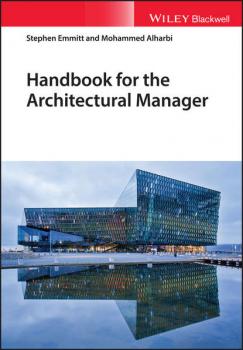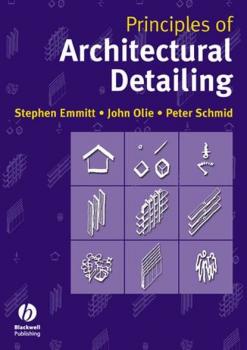ТОП просматриваемых книг сайта:
Stephen Emmitt
Список книг автора Stephen EmmittАннотация
The essential resource for becoming more effective in the highly competitive architectural marketplace Handbook for the Architectural Manager offers architects a comprehensive resource that brings together critical information on four interlinked areas: managing the architectural office, projects, stakeholders, and learning. Unlike other books on the topic that only stress management of the business or the management of projects, this book offers a guiding framework that encompasses the architectural manager's role in developing the practice’s competitive strategies and overseeing the project portfolio. Written by noted experts in the field, Handbook for the Architectural Manager is grounded in current research in which, for the first time, the components of architectural management have been analyzed systematically, tested, and developed for practical application. Designed to explore typical architectural management issues, the book provides clear and concise direction with practical step-by-step guidance as well as helpful checklists, templates and scenarios, and case studies to illustrate best practice. This essential resource: Offers a groundbreaking handbook that contains a comprehensive management framework for architectural practice Contains new insights and guidance based on solid research on managing the architectural practice Brings together in one book the best management techniques of the office, projects, stakeholders, and learning Includes a well-grounded critical review of the existing literature on the topic Designed for professionals in the field but written in accessible language suitable for students Handbook for the Architectural Manager offers a practical guide for overseeing the development of architectural designs and associated activities and ensuring all work is consistent (i.e. adheres to current standards, legislation, client specifications, and office protocols) and completed on time as well as information on staff development and learning.
Аннотация
Why are buildings detailed the way they are? Why do architects and engineers seem to come to the same kind of solutions to their detailing problems? Are we satisfied with such a situation? With environmental concerns so high on designers' agendas, the answer to this third question has to be 'no'. Collectively architects, engineers and specifiers need to revisit how they detail the built environment, and address the most important and potentially difficult area of the joint between materials and components. In Principles of Architectural Detailing the authors question the way in which buildings are detailed and in particular challenge familiar joint solutions. They offer practical guidance and a number of tools to help the student of architectural detailing in the decision-making process. The emphasis throughout is on using knowledge of construction in a creative and productive way to contribute towards a built environment that enhances our well-being and which is also sustainable.
Аннотация
Since the publication of the first edition of Architectural Technology, in 2002, there have been significant developments in the number of courses, the profile of the discipline as well as significant changes in the Construction sector. The Second edition of Architectural Technology addresses these challenges directly. Much greater emphasis is given to the three core themes of the book – Environmental Sustainability; Innovation; and Design. An increase in the visual material included reinforces the critical role of Design, aiding students to better translate conceptual designs into built artefacts. Building upon solid teaching practice from the previous edition, Architectural Technology is now more concisely structured to take the reader through the whole life cycle of a building, emphasising sustainability and building performance. Material on digital information, building information modelling (BIM) and information communication technologies has been updated. Most chapters have been re-titled to emphasise the importance of design and make the book more accessible to a wider range of students. Chapters conclude with updated/more extensive links to further reading. Architectural Technology, 2nd Edition: Bridges the knowledge gap between design and construction Tackles the core subjects of management, technologies and design from a sustainable building angle Addresses the buildability and performance of a design from a whole life perspective Thoroughly revised and updated this undergraduate level textbook is essential for Architectural Technology courses. Students studying Architectural Engineering, Architecture, Building Surveying; and more general Construction courses, will find the material invaluable.
Аннотация
Architectural Management represents the state of the art of research and practice in the field and includes contributions from leading international figures. The book looks back at over a decade of research into architectural management, considers the present challenges and opportunities, and looks to the future. You'll find a review of earlier work and developments as well as a focus on new research areas. The book is divided into six sections representing topical themes, each section contains two research-based chapters and one practical case study. Case studies are from six European countries – Belgium, Denmark, Finland, The Netherlands, Norway, and the UK.
Аннотация
The updated edition of the authoritative and comprehensive guide to construction practice The revised fourth edition of Barry’s Advanced Construction of Buildings expands on the resource that has become a standard text on the construction of buildings. The fourth edition covers the construction of larger-scale buildings (primarily residential, commercial and industrial) constructed with load bearing frames in timber, concrete and steel; supported by chapters on offsite construction, piling, envelopes to framed buildings, fit-out and second fix, lifts and escalators, building pathology, upgrading and demolition. The author covers the functional and performance requirements of the main building elements as well as building efficiency and information on meeting the challenges of limiting the environmental impact of buildings. Each chapter includes new “at a glance” summaries that introduce the basic material giving a good understanding of the main points quickly and easily. The text is fully up to date with the latest building regulations and construction technology. This important resource: Covers design, technology, offsite construction, site assembly and environmental issues of larger-scale buildings including primarily residential, commercial and industrial buildings constructed with load bearing frames Highlights the concept of building efficiency, with better integration of the topics throughout the text Offers new “at a glance” summaries at the beginning of each chapter Is a companion to Barry's Introduction to Construction of Buildings, fourth edition Written for undergraduate students and those working towards similar NQF level 5 and 6 qualifications in building and construction, Barry’s Advanced Construction of Buildings is a practical and highly illustrated guide to construction practice. It covers the materials and technologies involved in constructing larger scale buildings.
Аннотация
An authoritative, well-established, comprehensive, practical, and highly illustrated guide to construction practice Based mainly on domestic and residential buildings—and filled with extensive illustrations throughout—this concise text is the ideal introduction to the subject of building construction. It provides the basic material that readers need in order to understand the construction process for the majority of low rise buildings. The book explains construction technology through the key functional and performance requirements for the main elements common to all buildings. With a strong focus on building efficiency and meeting the challenges posed by limiting the environmental impact of buildings, and new “at a glance” summaries allowing you to grasp the salient points of each chapter, readers will find the text fully up to date with the latest building regulations and construction technology. Barry’s Introduction to Construction of Buildings, Fourth Edition starts by taking an in-depth look at the construction process and general principles of construction. It then offers comprehensive chapter coverage of site analysis, set-up, drainage and scaffolding; ground stability and foundations; floors, walls, doors, windows, roofs, stairs, and ramps; surface finishes; internal environment and energy supply; and water supply and sanitation. Deals with design, technology, site assembly, and environmental issues of domestic and residential buildings Thoroughly updated, with particular attention paid to the concept of building efficiency and improved integration of the topics covered to match current student needs New “at a glance” summaries at the beginning of each chapter A companion to Barry's Advanced Construction of Buildings, Fourth Edition Barry’s Introduction to Construction of Buildings is an excellent source of information for undergraduate students and those working towards similar NQF level 5 and 6 qualifications in building and construction.
Аннотация
Since the publication of the first edition of Architectural Technology, in 2002, there have been significant developments in the number of courses, the profile of the discipline as well as significant changes in the Construction sector. The Second edition of Architectural Technology addresses these challenges directly. Much greater emphasis is given to the three core themes of the book – Environmental Sustainability; Innovation; and Design. An increase in the visual material included reinforces the critical role of Design, aiding students to better translate conceptual designs into built artefacts. Building upon solid teaching practice from the previous edition, Architectural Technology is now more concisely structured to take the reader through the whole life cycle of a building, emphasising sustainability and building performance. Material on digital information, building information modelling (BIM) and information communication technologies has been updated. Most chapters have been re-titled to emphasise the importance of design and make the book more accessible to a wider range of students. Chapters conclude with updated/more extensive links to further reading. Architectural Technology, 2nd Edition: Bridges the knowledge gap between design and construction Tackles the core subjects of management, technologies and design from a sustainable building angle Addresses the buildability and performance of a design from a whole life perspective Thoroughly revised and updated this undergraduate level textbook is essential for Architectural Technology courses. Students studying Architectural Engineering, Architecture, Building Surveying; and more general Construction courses, will find the material invaluable.







